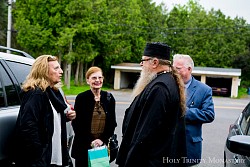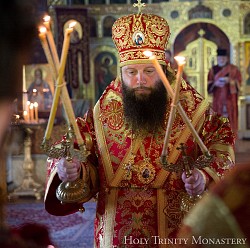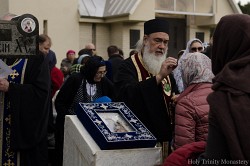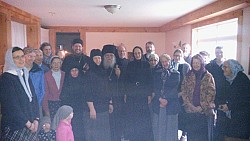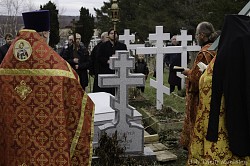The Monastery experienced a spiritual blessing on the eve of the Nativity Forefeast. On Saturday evening and Sunday morning his Eminence, Archbishop Gabriel presided over the divine services, greeting everyone on the future feasts of our Lord’s Nativity and Theophany. On Sunday evening a general matins was served in honor of the Forefeast and St. John of Kronstadt. Immediately following the service the abbot, Archimandrite Luke, tonsured Novice Lev (from Russia) and Novice Angelos (from Scotland) as rassophore monks.
00001
Holy Trinity Monastery and Seminary wishes you and your loved ones a blessed Feast of the Nativity of Our Lord!
"Your Nativity, O Christ our God, Has shone to the world the Light of wisdom! For by it, those who worshipped the stars, Were taught by a Star to adore You, The Sun of Righteousness, And to know You, the Orient from on High. O Lord, glory to You!"
00002
On the Theophany of our Lord, Archimandrite Luke and the clergy of Holy Trinity Monastery served the Great Blessing of Water.
00003
Dear supporters and friends of our monastery,
We are happy to announce that our Icon Studio's roof has been successfully replaced! With your prayers and financial assistance, we were able to complete the project before the roof collapsed under the weight of the winter's snow. Therefore, we offer a sincere thank you for your generosity during this campaign.
Having completed this work, we are not only going to continue the iconographic ministry started by Fr. Kyprian Pyzhov but have plans to expand production. As part of this, we are currently updating our website to make it more user-friendly, facilitating access to the over 1000 icons we have available. With this change, we hope to make it easy for the faithful to purchase high-quality, low-cost icons or to simply browse the index for their own edification.
May God bless your generosity!
In Christ yours,

Archimandrite Luke,
Abbot
00004
To begin Lent’s solemnity, the monastics and seminarians of Holy Trinity began the season with a week of intensive prayer and fasting.
The community awoke together at 4:30 in the morning to start its labor of participating in 10 hours of services. Midnight office, matins, hours, vespers, and compline, punctuated throughout with spiritual readings and advice, ensured that the day was dedicated to the glory of God and to promoting the rigorous self-examination that develops into true repentance. To reinforce this prayer schedule, the trapeza served one meal daily, the first two days offering only potatoes and pickled cabbage.
Asceticism is essential to develop spiritual strength in the future leaders of our church, and all Orthodox Christians. Training his body according to reason, the seminarian clears and focuses his mind, growing in spiritual discernment and intellectual acuity. These young men also loosen themselves from the bonds of the world, reorient their passions, and experience the fullness of Orthodox prayer. Not only does this help them cultivate habits that will remain with them throughout their lives, but it also nurtures the characteristics of a successful priest. This is why we believe that integrating a seminary education with a monastic environment is crucial to the students.
We invite everyone to celebrate this season of repentance with us. Click here for a calendar of services. For more information call us at 315-858-0945 or e-mail us at info@hts.edu.
00005
First Week, marked by 10-hours daily of church services and one meal a day, culminated with the Triumph of Orthodoxy, reinforcing the purpose of our Lenten struggle as the means by which we fully incorporate ourselves into “the Faith that has established the universe.” To amplify the solemnity of this celebration, seminarians and monastics participated in hierarchical vespers and liturgy with Bishop Jerome (Shaw), a former seminarian at Holy Trinity Seminary and one of the major translators of Russian Orthodox liturgical texts into English and Slavonic.
Before the service of the Triumph of Orthodoxy, including the anathemas that can be recited only in the presence of a bishop, Bishop Jerome reminded the congregation that the anathemas are not curses but are outlines that define the boundaries of the Church. They act as a guide that functions not negatively, by creating opposition to outsiders, but positively, preserving and protecting those inside the Body of Christ, deepening our understanding of the uniqueness of our divinely transmitted tradition.
With the first week of Lent completed, we pray that the Lord will preserve us and all the faithful for the remainder of this season so that we can successfully participate in His Resurrection on Pascha.
00006
Fr. Lazarus was born in Russia in 1940 during the Soviet Union. He and his parents were part of the underground catacomb church during the Soviet Union. In the early 1990’s Fr. Lazarus came to the U.S. He came to Jordanville and spent 1 year of seminary there. For various reasons he had to stop seminary and find a secular job near the monastery, but he continued to attend services on Sundays and Feast days throughout the year.
Then Fr. Lazarus became very sick and soon after was accepted as a Novice. No one knew what his illness was; he went to doctors and his medical records only showed was that he had some sort of “weakness.” Fr. Lazarus’ answer to this was that he didn’t want to know what it was, he only knew that it was a gift from God and the cure for his soul
In the following years he bore his illness with much patience and endurance, and without complaining. He knew the services very well and when he was no longer able to attend services because of his illness, he listened to the recordings of the services from his room, following them in the service books as well.
Fr. Lazarus was also very forgiving. He would often quote the words of our Saviour to forgive “up to seventy times seven” (Matt 18:22). If there was ever a quarrel between him and another he would frequently stop in the middle of the quarrel and ask forgiveness of the person and the quarrel would end immediately.
The last few months of his life were very peaceful. On the Saturday before the Sunday of Forgiveness Fr. Lazarus started to become very sick. During the first week of lent, he would go between being very sick and being normal. He received communion on Wednesday during Clean week and reposed on the following Friday evening.
+May the Lord grant rest to his soul.
00007
On the 9th anniversary of the blessed repose of Metropolitan Laurus, former primate of the Russian Orthodox Church Abroad as well as Abbot of Holy Trinity Monastery and Rector of Holy Trinity Seminary, March 3/16 a pannykhida was served in the monastery cathedral by the monastery clergy. The monastery brotherhood, as well as the seminary and our many neighbors and pilgrims, preserve zealously the memory of Vladyka Laurus, who was our abbot for 32 years and also headed the Church Abroad during one of its most crucial moments, the reconciliation of the Church Abroad with the church in Russia.
00008
Once a year during Great Lent, Holy Trinity Monastery and Seminary celebrate the Liturgy of the Presanctified Gifts of St. James, the Brother of the Lord. This is a very unique service, not only because the Liturgy of St. James is the oldest of the eastern liturgies extant but also because this presanctified version of the liturgy was translated by ROCOR’s Bishop Jerome (Shaw).
Harkening to the Holy Sepulcher and to pilgrimages to Jerusalem, the liturgy creates an atmosphere that is distinctly its own while being clearly within the eastern ethos. It reminds those present of the ancient origins of the Church, creating a bond to the sacred spaces that may be forgotten about in America.
Also, this gives the seminarians the experience of the richness and variety of Orthodox tradition, whose differences are held together by the firm bond of Faith. Lord willing, they will transfer this spirit to their parishes when they graduate.
00009
In the middle of Great Lent, the Holy Church provides the faithful with inspiration to continue with our Lenten struggle and reminds us of what lays ahead, the Holy Passion of Our Lord and Savior, Jesus Christ.
On the eve of Sunday, March 19 (March 6 O.S.), Sunday of the Veneration of the Cross, during the All-Night Vigil, a cross containing a relic of the Life-Giving Cross of the Lord, richly decorated with flowers, was brought out of the altar by the abbot of the monastery, Archimandrite Luke, attended by monastery clergy, for veneration by the faithful, this Sunday greatly increased in number by numerous pilgrims from Serbian Orthodox parishes. The procession was attended by the peeling of the church bells and accompanied by hymns.
00010
Archpriest Peter Heers recently delivered a presentation at the Lenten Clerical Retreat that took place at St. Alexander Nevsky Cathedral in Howell, New Jersey. The retreat began on March 20th and ended on March 22nd--the feast of the 40 Martyrs of Sebaste. The retreat took place under the aegis of two wonderworking icons--The Kursk Root Icon of the Mother of God and the Myrrh Streaming Icon of the Mother of God “Softener of Evil Hearts.” The event was presided over by His Eminence Metropolitan Hilarion who was also accompanied by Metropolitan Jonah, Bishop Nicholas of Manhattan, and Bishop Irenei of Sacramento. More on the retreat can be found here:
http://eadiocese.org/news_170322_2.html
http://eadiocese.org/news_170323_1.html
Fr. Peter Heers is currently the instructor of Old and New Testament at our seminary and his the translator/publisher of many books, some of which include his most recent book The Ecclesiological Renovation of Vatican II and other well known titles such as The Life of Elder Paisios, The Epistles of Elder Paisios, and The Truth of Our Faith.
Fr. Peter Heers, in his presentation, discussed the recent Council of Crete that took place in 2016. In his Lecture, Fr. Peter Heers addresses the problems that preceded the council and the secrecy surrounding the pre-conciliar text that were released just a few months before the council itself; he also addresses the implications of the decisions and actions of the Council of Crete.
To download a copy of Fr. Peter Heers' speech click here.
00011
One can safely say that the wonderful poetic creation of St. Andrew of Crete, “The Great Canon,” contains the very essence of the meaning of Great Lent, the period of time appointed by the Holy Church for repentance, which is the very core of the Orthodox way of life. For this reason the Church gives it a great prominence in its services during the Fast. If during the First Week of Lent, or Clean Week, the Great Canon is divided up during the Great Compline service the first four nights, the whole composition is read in its entirety during Matins of the fifth Thursday, divided up and dispersed during the service along with the reading of the Life of St. Mary of Egypt, perhaps one of the most spectacular examples extant in Church hagiography of repentance. This happens just before the last week of Great Lent, when the Church is already preparing us for Lazarus Saturday and the feast of the Entrance of the Lord into Jerusalem.
As is traditional, the abbot of the monastery, Archimandrite Luke, along with the monastery clergy, read the Great Canon in its entirety in the middle of the church, as mentioned previously, dispersed throughout the Matins service, while the choir chanted. As directed by the rubrics of this service, Fr. Luke read the first half of the life of St. Mary just before the Canon was started, and the second half was read after the first part of the Canon. The Life reflects the meaning of the Canon, which gives wonderful examples of repentance, foreshadowed in the Old Testament.
This service inspires us in our struggles during Great Lent, preparing us for the journey of the Lord’s Passion, leading up to His joyful Resurrection.
00012
The Akathist Hymn to the Most Holy Theotokos and Ever Virgin Mary, is one of the most beloved services of devotion that we have in the Orthodox Church. Tradition tells us that the Akathist was written in Constantinople, "the city of the Virgin," by St. Romanos the Melodist. The structure and format of the Akathist Hymn is so popular that many other Akathists have been written using its format. These include Akathists to Our Lord Jesus Christ, to the Cross, to various saints, etc.
The word "akathistos" translates as "not sitting," i.e., standing; normally all the faithful stand while it is being sung. The hymn has 24 stanzas, which alternate between long and short. Each kontakion ends with the singing of "Alleluia." While each longer ikos ends with the refrain: "Rejoice, O Bride Unwedded."
Most of the hymn is made up of praises directed to the Theotokos, beginning with the salutation of the Archangel Gabriel: "Rejoice." In each of the verses, the events related to our Lord's incarnation are remembered for our contemplation. In Ikos 1, the Archangel Gabriel marvels at the Divine self-emptying and the renewal of creation which occurs when Christ comes to dwell in the Virgin's womb. In Ikos 3 the unborn Forerunner and Baptist John prophetically rejoices. Then in Ikos 4 shepherds recognize Christ as a blameless Lamb, and rejoice that in the Virgin "the things of earth join chorus with the heavens." In the 5th Kontakion, the pagan Magi, following the light of the star, praise the Theotokos for revealing the light of the world.
Throughout the hymns progression, various people or groups encounter Christ and the Theotokos. Each bringing their own need; their own desire or expectation, and each finds his or her own spiritual need satisfied and fulfilled in Our Lord and in the Theotokos. Just as each generation of Orthodox, and each particular person who has prayed the Akathist, has also found in this hymn the inspired means of expressing gratitude and praise to the Theotokos for what she has accomplished for their salvation.
00013
This Tuesday (4/4/17), the Mystery of Holy Unction was provided to the faithful in the lower church of Holy Trinity Cathedral. Although the service began at 3pm when many people are still at work, the church was filled to capacity and even overflowing by the time the Mystery was administered.
Performed by most parishes once a year during the last weeks of Lent, the service of the Holy Unction is unique, as it offers Orthodox Christians in a public service what is usually only available privately at times of extreme illness. At Holy Trinity Monastery, it is performed completely with the seven priests called for by the rubrics. Prayers and supplications to the saints (especially to those who are known for their miraculous healings) culminate in the faithful’s making a circuit around the church to be anointed with holy oil by each of the priests. The priests anoint their foreheads, eyes, cheeks, ears, chest, and the tops and palms of the hands while praying for the healing of physical, emotional, and spiritual sufferings and diseases.
00014
00015
With God's grace, another Pascha approaches, and intensifying their preparations for the Great Feast, the monastics and seminarians of Holy Trinity Monastery and Seminary began Holy Week with a joyous Palm Sunday. At the end of the All-Night Vigil on Saturday evening, the faithful were anointed with holy oil and received a candle, a palm, and a pussy willow. Starting on Holy Monday, there will be continuous services at the Cathedral in the mornings and evenings.
As Christ’s entrance into Jerusalem marks the beginning of His path to Crucifixion and Resurrection, we are invited to follow the journey from the temporal glory of the King’s procession into His capital, to the daily unfolding of His betrayal, and into the Eternal glory of God’s redemption for all of mankind. As is always important to remember, Judas’ betrayal and the Lord’s Crucifixion are striking events that should exhort us to repentance and ascetic struggle while the Resurrection is the embodiment of God’s promise for those who struggle to the end. We pray that all have a very edifying Holy Week and a joyous Pascha!
00016
On these last three days of Holy Week, the depth and poignancy of the period descended upon the monastics and seminarians, and a profound spirit of silence and contemplation permeated everyone and everything. Beginning with Great and Holy Thursday and the Liturgy of St. Basil that culminated with the foot-washing service, these days were festive with services, including the Matins with the readings of the 12 gospels, Royal Hours, Vespers with the Holy Winding Sheet, 2:00 am Lamentations, the Reading of the Book of Acts, and the Great and Holy Saturday Midnight Office. After being slowly enveloped in the ethos of Holy Week with a complete cycle of Lenten services, everyone was even more struck by the triumphant and joyous arrival of Pascha at midnight. Truly, Christ’s Resurrection was worthily glorified! Christ is Risen!
To complete the Paschal service, the monastics, seminarians, and all the faithful pilgrims proceeded into the trapeza for the Paschal breakfast. We thank Christ for His saving Resurrection and gathering His faithful for this blessed and Great Feast. We also pray that all our friends have had an equally edifying Lent and Pascha!
00017
On Monday, May 8th the faithful at Holy Trinity Monastery Celebrated the Divine Liturgy of St. Mark the Evangelist in honor of his feast day. In the Orthodox Church there are three orders for the Divine Liturgy that are celebrated in every parish—those of St. John Chrysostom, St. Basil the Great, and the Presanctified Liturgy of St. Gregory the Dialogist. But in addition to these three there are also several other, rarer Liturgies, characteristic of certain places or celebrated on certain days. In recent years the Liturgy of St. James has become increasingly known and celebrated; akin to it is that of St. Mark.
The Divine Liturgy of St. Mark is the ancient, traditional main Liturgy of the Orthodox Church of Alexandria. With the discovery of a papyrus from the end of the fourth century in 1928, it also has the most ancient documentation of any Orthodox Liturgy still in use. This is the Liturgy of the great hierarchs of Alexandria, whose names occur constantly in our Church calendar: Ss. Athanasius the Great, St. Cyrill of Alexandria, St. John the Almsgiver, and countless others. St. Anthony the Great and the Desert Fathers prayed at this Liturgy, and knew and loved its prayers.
00018
With God's grace, Holy Trinity was able to celebrate with solemnity Pentecost weekend (June 3-6). The cathedral was festively decorated with freshly-cut saplings, some tall enough to reach the base of the dome. This very strikingly manifests the church's concept of recapitulation, as the entire universe has been transfigured through Christ and brought within the purview of the Church through the power of the Spirit Who gives life to all.
00019
On July 18 (N.S.), 1918, the day after the murder of the Russian Imperial family, the sister of the Empress, Grand Duchess Elizaveta Feodorovna, and other relatives of theirs, including the brothers, Princes Igor, Konstantin and Ioann Konstantinovich, were likewise killed by communist henchmen in Alpaevsk in the Ural Mountains area. On June 15, 2017, two sisters, granddaughters of Prince Ioann, visited Holy Trinity Monastery for the first time.
00020
On the eve of the Church commemoration of Saints Sergius and Herman of Valaam (June 28 O.S.), the monastery had its own feast, the tonsure of Riassophore Monk John (Weeks) to the Small Schema and Novice Stephen (Manduke) to the Riassa. This grace-filled event took place just as the Church is finishing the fast of the Apostles.
00021
This year, the monastery’s commemoration of the Royal Martyrs was especially festive. It must be noted that it was 99 years ago that they suffered for Christ.
00022
On the feast of St. Seraphim of Sarov, Holy Trinity Monastery was granted a special blessing: during the feast day services, the brotherhood and faithful prayed before an icon of the beloved Russian saint with segments of his hair, a piece of the rock upon which he prayed, and a part of his clothing. The icon was placed for all to venerate in the middle of the church, and the akathist to St. Seraphim was sung before it during Matins.
00023
In the Greek Chasoslov (Orologion) of 1897 is explained thus the derivation of this feast: "By reason of the sicknesses, often everywhere occurring in August, from of old customarily it was done at Constantinople to carry out the Venerable Wood of the Cross along the roads and streets for the sanctifying of places and for the driving away of sicknesses. On the eve (31 July), carrying it out from the imperial treasury, they placed it upon the holy table of the Great Church (in honour of Saint Sophia – the Wisdom of God).
00024
On August 18, 2017 the Vigil was served for the great feast of the Lord’s Transfiguration. In addition to the brotherhood, neighbors, and some seminarians who have remained part of the summer, we were joined by many pilgrims, as is usual during the summer months. A group from Chicago, led by Fr. Leonardo Naidzions, cleric of the cathedral of the Protection of the Mother of God, joined us for the Divine Liturgy the following morning.
00025
In the Holy Trinity Monastery, the feast of the Dormition of the Mother of God has always been celebrated with special solemnity. Part of this is due, undoubtedly, to the fact that the Mother of God is especially venerated by monastics as our heavenly abbess, the directress to Heaven. Also, this is due to the fact that the feast is tied in to our Labor Day weekend celebration of the memory of our heavenly protector, the Venerable Job of Pochaev, as will be explained shortly.
00026
The monastery zealously keeps the memory of all of the reposed brethren of the brotherhood, those who have ended their lives within the walls of our sacred habitation. On the anniversary of their repose and also on their Name’s Day, the monastics chant “Memory Eternal” after the noon-time meal. Of course, all the monastics are prayed for every day, both living and dead, during the Proskomedia.
00027
In the 1950’s, thousands of displaced people, or people displaced by the trauma of World War II, especially from Eastern Europe, found a new life in America. Many of them were Russian Orthodox people, who had suffered deprivation of their age-old culture, especially of their faith, under communism, and now found themselves in a very strange culture. It was not long before so many of them found their spiritual home in the Holy Trinity Monastery in Jordanville, New York.
00028
On September 10, 2017, the brethren of the Holy Trinity Monastery celebrated the feast of the Opening of the Relics of St. Job of Pochaev (August 28 O.S.). As in a previous posting was described the Labor Day Weekend festivities in honor of St. Job, the brethren in a perhaps more intimate way, commemorated their heavenly protector. As is peculiar to this feast, since the basement church of the Holy Trinity Monastery cathedral is dedicated to the memory of St. Job, the services were conducted there.
00029
On September 11 (August 29 O.S.), the holy Church commemorates the Beheading of St. John the Baptist. Even though not numbered among the twelve great feasts of the Orthodox Church, nonetheless it is a very important holiday. As usual, the All-Night Vigil and Divine Liturgy were celebrated as is usual on such feasts in the monastery.
00030
On September 21 (8 O.S.), the first of the twelve great feast days of the Orthodox Church year was celebrated in the Holy Trinity Monastery, the Nativity of the Most Holy Theotokos, the church new year being September 1/14. The usual All-Night Vigil and Divine Liturgy were celebrated with the usual monastery solemnity.
00031
Some of the twelve great feasts of the Church come in two’s. Such was the case of the Transfiguration of Our Lord and the Dormition of the Theotokos, and so now also is the case of the Nativity of the Theotokos and the Exaltation of the Life-Giving Cross. At Holy Trinity Monastery the latter is celebrated with extra solemnity in that with the blessing of the Metropolitan, Archimandrite Luke is granted the right to perform the rite of the Elevation of the Cross, much to the spiritual joy of the monastics, the seminarians and the many faithful who attend this service, conducted toward the end of the All-Night Vigil.
00032
The fall 2017 Eastern American Diocesan clergy conference was held in the Holy Trinity Monastery from October 23-26. The Hawaiian Myrrh-streaming icon of the Most Holy Theotokos was present from October 26 through the weekend, when the annual pilgrimage from Washington, D.C. took place.
00033
This past weekend, October 28-29, was held the annual pilgrimage from Washington, D.C. along with pilgrims from Brooklyn, Lakewood, N.J. and many other parts of our country, to commemorate the tragic murder of the guardian of the Iveron Myrrh-streaming icon of the Most Holy Theotokos. This year had special resonance, it being the 20th anniversary of this sorrowful event.
00034
On October 31, the superior of the Holy Trinity Monastery, Archimandrite Luke, celebrated his Name’s Day in the usual way. He celebrated Divine Liturgy at the usual time in the morning, at 6AM. The noon-day meal was festive, at the end of which, Igumen Theophylact congratulated Fr. Luke in the name of the brotherhood, the professors and teachers of the seminary and our many pilgrims. After the monastic “mnogaya letiye,” all were invited to coffee and dessert in the former typographia, which gave a wonderful opportunity for monastics, seminarians, with the professors to engage in brotherly conversation.
00035
Today, when the Holy Church commemorates the memory of the Holy Apostle James, Brother of the Lord in the flesh, as has been customary in the monastery, the Liturgy of the Apostle James was concelebrated by the monastery clergy. This ancient liturgy, which was the basis of the liturgies of St. John Chrysostom and St. Basil the Great, impresses one with its great prayerfulness and a connection with the Old Testament.
00036
On Wednesday, November 08, 2017, at 5:30 EST, Mitered Archpriest Wsewolod Drobot (HTOS 1965) reposed in the Lord. Fr. Wsewolod was the retired rector of the Nativity of the Mother of God parish in Albany, NY, and presided as the new church building was completed. Fr. Wsewolod was born on April 1, 1930 in Zaporozhiye, Ukraine. He was a clergyman for 57 years from the time of his ordination to the diaconate. He was a graduate of Holy Trinity Orthodox Seminary and lived in a house near the monastery with his family. Fr. Wsewolod is survived by their seven children and seven grandchildren, his matushka Nadezhda having reposed in 2015. May God grant Fr. Wsewolod the Heavenly Kingdom!
00037
On Saturday, November 11 2017 the funeral and burial of Fr. Wsewolod took place at his beloved Holy Trinity Monastery. Fr. Wsewolod was the rector of the Holy Nativity of the Mother of God parish in Albany for 50 years, but he also labored within the Holy Trinity Monastery, even earlier, partaking in many aspects of the life of the monastery. So it was only fitting that the monastery served as the place of his funeral.
00038
Prior to their graduation, Holy Trinity Seminary’s graduation class of 1971 erected a magnificent 40 foot tall cross on the top of the hill overlooking Holy Trinity Monastery in Jordanville, NY. Since then, this cross has become a part of the local scenery, something that is very strongly associated with the imagery of the monastery.
Although the cross has been already renovated once, time and severe weather conditions have taken their toll on it. This past summer, pilgrims from the Moscow-based Institute of Russian Athos made an initial donation that has been used to paint the cross. This is an impressive beginning, but the monastery still needs $4,000 more to renovate the entire plot. You can also be part of this noble cause, donating via PayPal below here. Please mark your donation for the Golgotha site renovation.
00039
Two years ago Metropolitan Hilarion blessed the founding of a woman’s monastic community, in the Russian tradition, using English as its liturgical language and under the spiritual administration of Holy Trinity Monastery. Finally, at the end of this summer, property with buildings were found near West Winfield, NY. This fall the property was blessed and recently on the patronal feast of the community, “Quick to Hear” Icon of the Mother of God, Vigil and Liturgy were served. We ask for the prayers of the faithful for this newly formed community. Their address is 235 Cole Hill Rd, Richfield Springs, NY 13439.
00040
On December 1, 2017, the monastic funeral of the newly-reposed Schema-Archdeacon Amvrossy was served at Holy Trinity Monastery. Fr. Amvrossy reposed on November 26 in San Francisco where he had served for 34 years in the Cathedral of Our Lady Joy of All Who Sorrow.








